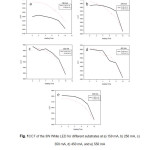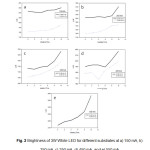Optical performance of LED using Carbon doped AlN thin film as thermal interface material on metal substrate
Shanmugan Subramani*, Norazlina M. S., and Mutharasu Devarajan.
School of Physics, UniversitiSains Malaysia (USM), 11800, Minden, Pulau Pinang, Malaysia.
DOI : http://dx.doi.org/10.13005/msri/110103
Article Publishing History
Article Received on : 20 Aug 2014
Article Accepted on : 31 Aug 2014
Article Published : 25 Aug 2014
Plagiarism Check: Yes
Article Metrics
ABSTRACT:
Carbon doped Aluminium Nitride (C-AlN) thin film was synthesized on Al and Cu substrates using RF sputtering and used as heat sink for high power LED. The optical properties of LED such as correlated color temperature (CCT) and brightness (LUX) was recorded by spectrometer and tested for various driving currents. Increased lux level was observed for high driving currents and showed the performance C-AlN thin film as good thermal interface material at high driving currents.The observed CCT values were in between 6180-6900 K and increased for high driving currents. At the lower driving current, CCT value was high for C-AlN on Cu than on Al.overall, the observed optical properties of LED using C-AlN thin film as thermal interface material was suggested to explore the usage of C doped AlN thin film as effective thin film thermal interface material for thermal management in solid state lighting applications.
KEYWORDS:
Interface material; thermal management and junction temperature.
Copy the following to cite this article:
Subramani S, Norazlina M. S., Devarajan M. Optical performance of LED using Carbon doped AlN thin film as thermal interface material on metal substrate. Mat.Sci.Res.India;11(1)
|
Copy the following to cite this URL:
Subramani S, Norazlina M. S., Devarajan M. Optical performance of LED using Carbon doped AlN thin film as thermal interface material on metal substrate. Mat.Sci.Res.India;11(1). Available from: http://www.materialsciencejournal.org/?p=472
|
INTRODUCTION
Light emitting diodes (LEDs) is the device that has higher competition in the industry and one of the promising devices. It is an alternative lighting that reduces the energy consumption and maintenance cost for commercial and residential installations[1-3]. However,the overheating of this device due to higher input current cause major problem. Thermal management is an important part in the production of LEDs which has significant impact on the lifetime and performance of LEDs. Excess heat during the operation directly influences both short term and long term performance of LEDs. The short-term effects are color shift while the long-term effect is accelerated lumen depreciation and thus shortened useful life. In terms of thermal characteristic of LED, junction temperature is an important parameter which is to determine the heat dissipation efficiency fromp-n junction [4,5]. Higher the junction temperature causes shorter life-span[6]. This junction temperature can be determined by the thermal transient method[7].
This paper reported on optical performance of a LEDs with C-AlN as thermal interface material as a function of input current at atmospheric pressure. The CCT and lux values are captured to investigate the optical performance of the LEDs.
EXPERIMENTAL TECHNIQUES
C-AlN thin films were deposited on metal substrates (Cu and Al) by RF magnetron co-sputtering using a C target with 99.9% purity and Al target with 99.9% purity. The Cu and Al substrates were cleaned by rinsing in ultrasonic bath of acetone and then loaded in the central region of the substrate holder. The sputtering chamber was initially evacuated to the base pressure of about 5.5 x 10-5 mbar, and the vacuum pressure was maintained as 6.17 x 10-3 mbar with gas ratio of Ar:N2=18:2 for all film deposition. Prior to the film deposition, pre-sputtering was carried out for 5 min to remove any other contaminants on the surface of the material source target. For doping C to AlN, AlN thin film was deposited at power 150 W followed by C thin films which was deposited at power 100 W. C-AlN films were grown at room temperature with C using RF power of 100W and Al using DC power of 150W.
The optical performance of LEDs was captured by an MK350 LED meter (Make: UPRtek) spectrometer in determined CCT, luminosity of light and peak wavelength in still air box. The experiment was carried out using a Thermal Transient Test (T3Ster) at various driving current (150 Ma, 250 Ma, 350 Ma, 450 Ma, and 550 Ma) in a still air box at room temperature. C-AlN was used as interface material on metal substrates with LED forward biased at 600s and heating time were captured 2 min interval.
RESULTS AND DISCUSSION
The LEDs is mounted on the two different metal substrates that are coated with C-AlN and AlN. Table 1 shows a comparison of Junction temperature (TJ)of C-AlN on Al and Cu substrates and AlN on Al and Cu. It is clearly shows that from the table 1 the junction temperature increased with respect to driving current. It is also observed that the change in TJ values of C-AlN on metal substrates is comparatively high at higher driving current 550 mA (∆TJ = 4.47°C). From the table 1 also shows Al substrate has high TJ value than Cu substrates.
Table 1: Junction temperature of C-AlN on metal substrate
|
|
|
Junction Temperature
(TJ(°C) )
|
|
|
|
Driving current (mA)
|
C-AlN on Al
|
AlN on Al
|
C-AlN on Cu
|
AlN on Cu
|
|
150
|
18.70
|
19.19
|
16.15
|
17.28
|
|
250
|
32.61
|
33.87
|
29.87
|
30.71
|
|
350
|
47.39
|
49.70
|
42.94
|
45.56
|
|
450
|
64.05
|
70.09
|
59.28
|
62.08
|
|
550
|
80.76
|
89.86
|
74.11
|
82.40
|
This is may be due to Cu (401W/m.K) has high thermal conductivity than Al (205W/m.K). It is also noticed that the AlN thin films does not shows good thermal spreader than C-AlN thin films since the junction temperature AlN thin films on Al substrate as much as high 89.86°C at high driving current (550 mA).
In order to understand the optical behavior of the given LED, the optical properties such as Correlated color temperature (CCT), luminosity and peak wavelength were recorded and the observed result are shown in fig. 1-2. CCT is a measure of light source color appearance. It is also describing color tone in a specification of white light sources along the dimension from warm to cool. The recorded CCT valuesof the 3W cool white LED at various driving current for C-AlN on Cu and Al substrate boundary condition are plotted against the LED heating time duration as shown in Fig. 1(a)-(e).
 |
Fig1: CCT of the 3W White LED for different substrates at a) 150 mA, b) 250 mA, c) 350 mA, d) 450 mA, and e) 550 mA
Click here to View Figure
|
As can be seen from the Fig. 1, CCT values are changing with respect to driving current of the LED along with the interface material applied on various substrates.
 |
Fig2: Brightness of 3W White LED for different substrates at a) 150 mA, b) 250 mA, c) 350 mA, d) 450 mA, and e) 550 mA
Click here to View Figure
|
The observed values are in between 6180-6900 K. It also reveals that some value of C-AlN on Al started to overlap on C-AlN on Cu when reach 250mA of driving current and totally high at 550mA. Furthermore, the CCT value decreases with respect to heating time.Luminosity is an important optical property since it decides the application of LED lights. Luminosity is measured in terms of LUX (lumens/watt) and describes the effective light output for given driving current. To analyze the influence of C-AlN on changing the luminosity of the given LED, the LUX values of cool white 3W LED was recorded for various driving current and the observed data are plotted against burning time as shown in fig. 2(a-e).
From Fig. 2, it indicates that C-AlN on Cu has lower luminosity than C-AlN on Al substrate. However, at the higher driving current, the LUX value of LED fixed on C-AlN/Cu shows overlapped on that of LED fixed C-AlN/Al. From the figure, it clearly shows that both interface material shows increasing luminosity when respect to increase driving current. Nevertheless, the lux level decreases as the heating time increased.
The observed peak wavelength (λpeak) was varied from 449 nm to 450 nm for all boundary conditions irrespective to the driving currents. Theλpeak value is not significant for high power LED.From this observation the observedpeak wavelength is red shifted for C-AlN on Al and Cu substrate.Moreover, shifting peak wavelength is attributed from junction temperature means wavelength is proportional to junction temperature [8].
CONCLUSION
In this paper, the CCT and lux values were obtained by capturing the result by using spectrometer for optical analysis. From the CCT and lux graph obtained the CCT values in between 6180-6900 K for various driving current from 150 mA to 550 mA. From this research, an increase in driving current will causes an increase the luminosity of light. Means increase driving current increase their optical efficiency.
REFERENCES
- Anithambigai, P., Dinash, K., Mutharasu, D., Shanmugan, S., Lim, C. K. Thermochimica Acta,523(1-2), 237-244, (2011)
CrossRef
- Steve.(2013).Reduce power consumption in your home by installing LED lighting.Slideshare.Retrieved fromhttp://www.slideshare.net/Stevepearson45/reduce-the-power-consumption-in-your-home-by-installing-led-lighting.
- Weng, C. J. Int.Com. in Heat and Mass Transfer. 36(3), 245-248(2009).
CrossRef
- Package Related Thermal Resistance of LEDs.(2014).Osram opto Semiconductor.Retrieved from catalog.osramos.com/catalogue/catalogue.do?act=downloadFile (2014).
- Thermal Design Considerations.(2000).Philips Semiconductor. Retrieved from.www.nxp.com/documents/thermal_design/IC26_CHAPTER_6.pdf
- Robert, L.(2009) Lifetime of White LEDs. U.S Department of Energy. Retrievedfromapps1.eere.energy.gov/buildings/publications/…/lifetime_white_leds.pdf
- Chin, P. C.,Mutharasu, D., Liew, W. C.(2011).Thermal characterization of a highpower infrared emitter as a function of input current, IEEE,KotaKinabalu,17-19 Oct 2011, 1-5.
- Hong, E. and Narendran, N.(2004). A method ffor projecting useful life of LED lighting systems.Retrieved fromhttp://www.streetlightingresearch.net/programs/solidstate/pdf/projectingusefullife.pdf
Views: 441
 This work is licensed under a Creative Commons Attribution 4.0 International License.
This work is licensed under a Creative Commons Attribution 4.0 International License.
 Material Science Research India An International Peer Reviewed Research Journal
Material Science Research India An International Peer Reviewed Research Journal




